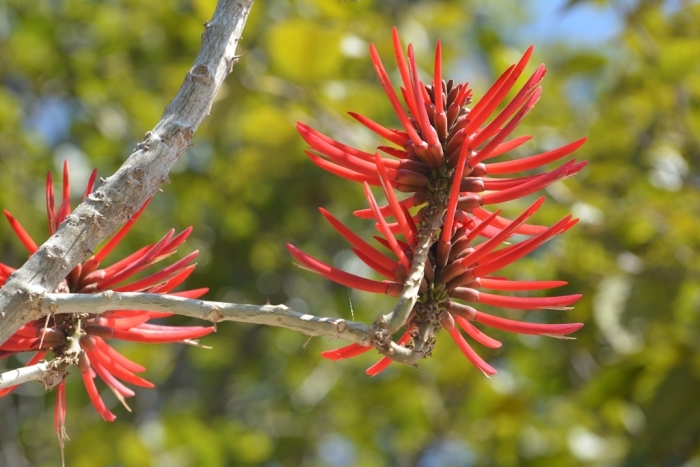Elequeme
(Erythrina berteroana)
Elequeme (Erythrina berteroana)
/
/

Neptalí Ramírez Marcial
CC BY 4.0
Image By:
Neptalí Ramírez Marcial
Recorded By:
Copyright:
CC BY 4.0
Copyright Notice:
Photo by: Neptalí Ramírez Marcial | License Type: CC BY 4.0 | License URL: http://creativecommons.org/licenses/by/4.0/ | Rights Holder: Neptalí Ramírez Marcial | Publisher: iNaturalist | Date Created: 2019-02-21T11:10:58-08:00 |

































Estimated Native Range
Summary
Erythrina berteroana, commonly known as elequeme, gallito, machete, and poró de cerca, is a small deciduous tree native to the tropical dry forests, often found in open woodlands and forest edges in Mexico, Central America, and northern South America. It typically grows to a height of 40 to 50 feet with a slender trunk that rarely exceeds a diameter of 8 inches. The tree is characterized by its smooth, greenish bark, which is armed with stout, conical thorns. The leaves are trifoliate, with three leaflets on each petiole, and provide a lush green canopy. Erythrina berteroana is notable for its vibrant pink or red tubular flowers, which are highly attractive to hummingbirds and bloom from December to March. The flowers are showy and create a striking display against the foliage.
In cultivation, Erythrina berteroana is valued for its ornamental flowers and its ability to attract wildlife, particularly hummingbirds. It is used in tropical and subtropical landscapes for shade, as a specimen tree, and occasionally as a living fence due to its thorny branches. This species prefers full sun to partial shade and thrives in well-drained soils. It is drought-tolerant once established, making it suitable for xeriscaping. While it is relatively low-maintenance, it is important to be aware of its potential invasiveness when grown outside its native range; gardeners should consult local regulations before planting.CC BY-SA 4.0
In cultivation, Erythrina berteroana is valued for its ornamental flowers and its ability to attract wildlife, particularly hummingbirds. It is used in tropical and subtropical landscapes for shade, as a specimen tree, and occasionally as a living fence due to its thorny branches. This species prefers full sun to partial shade and thrives in well-drained soils. It is drought-tolerant once established, making it suitable for xeriscaping. While it is relatively low-maintenance, it is important to be aware of its potential invasiveness when grown outside its native range; gardeners should consult local regulations before planting.CC BY-SA 4.0
Plant Description
- Plant Type: Tree
- Height: 20-40 feet
- Width: 20-30 feet
- Growth Rate: Moderate
- Flower Color: Orange, Red
- Flowering Season: Summer
- Leaf Retention: Deciduous
Growth Requirements
- Sun: Full Sun
- Water: Medium
- Drainage: Fast
Common Uses
Bee Garden, Bird Garden, Butterfly Garden, Edible*Disclaimer: Easyscape's listed plant edibility is for informational use. Always verify the safety and proper identification of any plant before consumption., Showy Flowers
Natural Habitat
Native to tropical dry forests, open woodlands, and forest edges
Other Names
Common Names: Coral Tree, Dedal de Dama, Machete Tree
Scientific Names: , Erythrina berteroana, Erythrina berteriana, Erythrina neglecta,
GBIF Accepted Name: